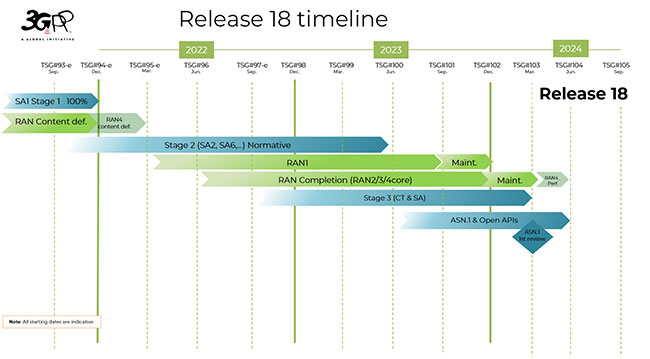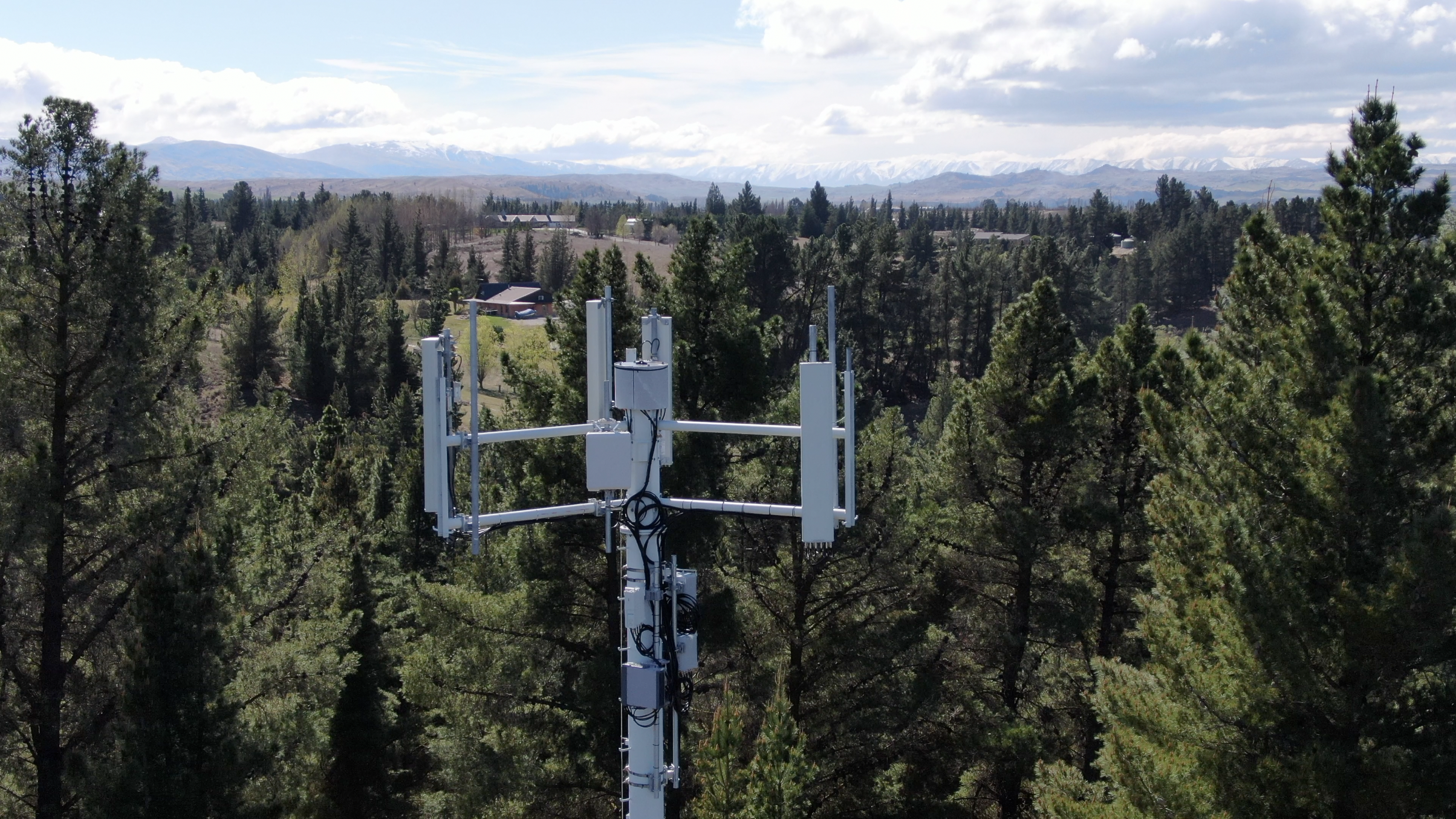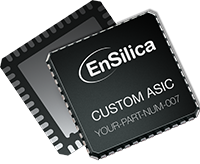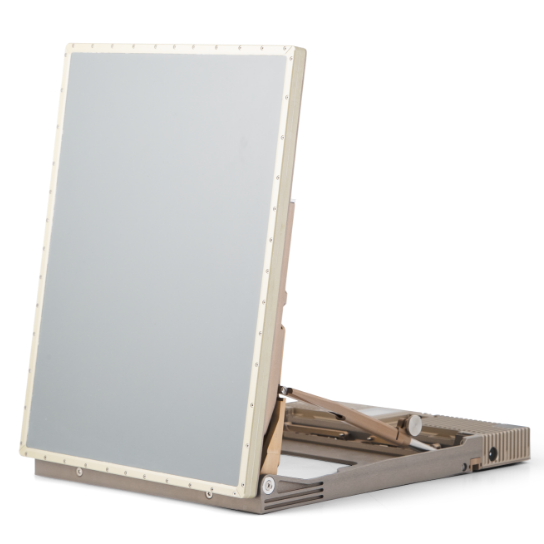SATCOM as a Service
SatCom market services, ITU-R WP 4B, 3GPP Release 18 and ABI Research Market Forecasts
Satellite Communications (SatCom) market services will include fixed broadband Internet access, satellite Internet of Things (IoT), and Non-Terrestrial Network (NTN) mobile (satellite-to-cell services). These services will experience growth due to more satellite players launching networks in Low Earth Orbit (LEO), alongside an increasing interest in terrestrial and satellite network convergence.
The market is expanding rapidly and major players are quickly recognizing its potential. While satellite networks are experiencing rapid changes due to innovations in small satellites and nanosatellites, Software-Defined Networking (SDN) applications, High Throughput Satellites (HTS), and inter-satellite links, terminals on the ground continue to see growth, with Very Small Aperture Terminals (VSAT) SatCom solutions maintaining dominance in the market.
According to Research & Markets, the SATCOM equipment market is valued at $22.6 billion in 2023 and is projected to reach $38.7 billion by 2028, at a CAGR of 11.3% from 2023 to 2028. Based on frequency, the multiband frequency is projected to register the highest during the forecast period 2023-2028.
………………………………………………………………………………………………………………………………..
ITU-R Working Party 4B (WP 4B) is responsible for recommendations related to: Systems, air interfaces, performance and availability objectives for FSS, BSS and MSS, including IP-based applications and satellite news gathering.
WP 4B has a working document which is a preliminary draft new Report ITU-R M.[SAT IOT] – Technical and operational aspects of satellite Internet of Things (IoT) applications, a work plan and working document on Work plan for development of a preliminary draft new Report ITU-R M.[DEVELOPMENT AND TECHNOLOGY TRENDS FOR THE SATELLITE COMPONENT OF INTERNATIONAL MOBILE TELECOMMUNICATIONS]. WP5D last meeting was July 2023, but the following meeting won’t be till April 29 to May 5, 2024!
Yet the real SatCom air interface specifications work is being done by 3GPP, under the umbrella term of NTN:
3GPP Release 17 introduced new network topologies that are based on High-Altitude Platforms (HAPs) and LEO and Geostationary Orbit (GEO) satellites. Crucially, these laid out the foundation for satellite IoT and NTN mobile as Release 17 extended the cellular IoT protocols, LTE-M and Narrowband (NB)-IoT for satellites. This enabled two new standards for satellite networks, IoT-NTN and New Radio-NTN (NR-NTN). SatCom with individual mobile devices will close gaps in the terrestrial cellular networks to provide global connectivity. It will target issues like unreachability and service continuity in underserved regions and improve network resilience around the world.
The discussion items in the upcoming 3GPP Release 18 are expected to enhance NTN Mobile and Satellite IoT as key satellite enabled services. While Release 17 established the standards for IoT-NTN and NR-NTN, Release 18 will evolve both those specifications for IoT and satellite-to-mobile broadband connectivity. For NR-NTN, there are plans to run NR-NTN on Radio Frequency (RF) spectrum above 10 Gigahertz (GHz) to serve the aerospace and maritime industry, alongside businesses and buildings (with building-mounted devices). Release 18 is also expected to include enhancements in satellite backhaul, specifically the dedication of more spectrum for Mobile Satellite Services (MSS), with approximately 80 Megahertz (MHz) of uplink in the L-band and downlink in the S-band.
At the same time, improvements targeted toward Fixed Satellite Services (FSS) will be brought about by Release 18 as well, with the consideration of more bands in the Ka frequency bands for downlink (17.7 – 20.2 GHz) and uplink (27.5 – 30 GHz). While the specifics of 3GPP Release 18 are still in development, 3GPP has already established the boundaries of Release 18 that will benefit the SatCom market. Furthermore, with the recent mergers of Eutelsat and OneWeb in 2022 and Viasat and Inmarsat in 2023, in addition to the launch of Infrastructure for Resilience, Interconnectivity and Security by Satellite (IRIS2), a project endorsed by the European Union (EU) in 2022 to enhance connectivity throughout the EU, more partnerships and agreements are expected to arise ahead of the official launch of 3GPP Release 18 in 2024.

ABI Research says that 3GPP Release 18 aims to unlock new capabilities toward the evolution of 5G-Advanced and establish new regulatory requirements, along with new bands, while optimizing satellite access performance. The market research firm forecasts the market value for worldwide SatCom to be US$94.9 billion by 2027 (MD-SATCC-102). The growth of NTN mobile, in addition to broadband, will drive the market moving forward, with special mention of NTN mobile revenue likely to shoot from 0.2% of the total revenue in 2023 to 8.8% of the overall SatCom revenue by 2027. ABI Research recognizes that greater value has been placed on the protocols, such as 3GPP Release 18 and beyond, that will develop and nurture the SatCom space.
Strategic partnerships between terrestrial and NTN operators, solution providers/Communication Service Providers (CSPs), and wireless end-user equipment vendors are currently on the rise and will be critical in expanding the ecosystem and market toward 2027. For instance, MediaTek and Qualcomm have partnered with Inmarsat and Iridium, respectively, to target the NTN mobile market.
Meanwhile, AST SpaceMobile has agreements with AT&T, Rakuten Mobile, and several other mobile network operators. Where satellite IoT is concerned, CSPs like Deutsche Telekom have established partnerships with Intelsat and Skylo, whereas Telefónica and Sateliot are working together to trial satellite IoT connectivity. While partnerships are a good indicator of SatCom’s market potential, it is important that operators consider differentiated and unique product offerings for clients.
The value proposition that SatCom players can offer their target market will be essential for this process. Some examples might include integrated end-to-end IoT solutions for maritime, offshore connectivity, or end-to-end NTN mobile solutions that marry NTN hardware and software for satellite connectivity. Nonetheless, the creation of new value added services will benefit from 3GPP Release 18, in addition to driving the overall momentum and agenda of the Satellite Communications market.
References:
https://www.itu.int/en/ITU-R/study-groups/rsg4/rwp4b/Pages/default.aspx
ABI Research’s Highlights & Developments in the SatCom NTN Market (PT-2740)
https://finance.yahoo.com/news/global-satellite-communication-satcom-equipment-214500758.html
https://www.3gpp.org/specifications-technologies/releases/release-18
Samsung announces 5G NTN modem technology for Exynos chip set; Omnispace and Ligado Networks MoU
GSMA- ESA to collaborate on on new satellite and terrestrial network technologies
ABI Research and CCS Insight: Strong growth for satellite to mobile device connectivity (messaging and broadband internet access)
China Mobile Partners With ZTE for World’s First 5G Non Terrestrial Network Field Trial
ITU-R M.2150-1 (5G RAN standard) will include 3GPP Release 17 enhancements; future revisions by 2025
Spark New Zealand partnering with Lynk Global to offer a satellite-to-mobile service
Spark, the leading telco in New Zealand, announced it is collaborating with Lynk Global to offer a satellite-to-mobile service, aiming to enhance connectivity for its customers. Later this year, selected customers will be offered a free trial of the service.
The satellite-to-mobile service will enable periodic text messaging throughout the day during the initial trial. However, as more commercial satellites are deployed, Spark intends to expand the service in 2024 to offer more regular connectivity. The ultimate goal is to provide voice and data services to customers once they become reliably available.
Spark said while satellite coverage cannot reach 100 percent due to the requirement of a clear line of sight to the sky, it offers an additional layer of resilience, especially in light of increasingly severe and frequent weather events caused by climate change. By leveraging satellite connectivity, Spark aims to extend its network reach to areas that are currently underserved by traditional mobile coverage.
According to the Spark press release, the trial period will provide an opportunity to refine and enhance the service in alignment with the increasing number of satellites in orbit. Integration into Spark’s network and regulatory approval are also essential steps before the service can be officially launched.

Photo Credit: Spark New Zealand
The collaboration with Lynk Global and the existing partnership with Netlinkz, which aims to provide satellite broadband services, are part of Spark’s broader strategy to leverage satellite technology as part of its connectivity offering to customers. Spark says it is actively working with various partners to expand the range of services it can deliver.
In a separate announcement last week, Spark revealed its partnership agreement with Netlinkz to provide Starlink business-grade satellite broadband to customers later this year. This initiative follows ongoing trials with a select number of New Zealand businesses.
Spark Product Director, Tessa Tierney, said, “We believe satellite has an important role to play in connecting Aotearoa New Zealand. While satellite can’t provide 100% coverage – as you need a clear line of sight to the sky to get connected2 – it certainly adds an additional layer of resilience, particularly now, as we face increasingly severe and frequent weather events due to climate change. And once there are more satellites launched and the service is available more broadly, it will allow our mobile customers to start to use their phones in more areas that aren’t reached by traditional mobile coverage.”
“We know that our customers will be eager to start using satellite messaging, but the technology is still evolving, so the service and experience will improve and expand as the number of satellites in the sky increases. That’s why we’ve chosen to trial this technology with some of our customers first, to make sure we can offer a great product to our customers when we make it widely available. We also need to integrate the technology into our network and achieve regulatory approval to launch the service. But we are excited to see the possibilities this creates for New Zealanders and will be working hard to make it widely available as soon as we can.
“This partnership with Lynk, and our partnership with NetLinkz to offer a satellite business connectivity service are part of Spark’s broader strategy to use satellite as a part of our connectivity offer to customers. We are continuing to work with these and other potential partners to broaden the services Spark can offer.”
Spark’s introduction of satellite-to-mobile services and business-grade satellite broadband underscores its commitment to enhancing connectivity options for customers across the country, particularly in underserved areas. Spark said further details, including eligibility criteria and timelines, will be disclosed in the coming months.
………………………………………………………………………………………………………………………………………………………………………..
References:
https://www.sparknz.co.nz/news/Spark-to-launch-satellite-to-mobile-service/
Spark New Zealand to Launch Satellite-To-Mobile Service With Lynk Global
European Space Agency & UK Space Agency chose EnSilica to develop satellite communications chip for terminals
UK based EnSilica, a fabless ASIC and mixed signal chip maker, has announced a contract to develop a new chip to address the next generation of mass market satellite broadband user terminals.

The contract has been awarded through the European Space Agency’s (ESA) Advanced Research in Telecommunications Systems Core Competitiveness program (“ARTES CC”), through the support of the UK Space Agency.
The chip in development will enable a new generation of lower-cost, low-power satellite broadband user terminals, which track the relative movement of low-earth orbit satellites and allow users to access high bandwidth connectivity when out of reach of terrestrial networks.
Use cases include satellite communication-on-the-move (SOTM) for automotive, maritime, and aerospace connectivity as well as extending broadband access to users without internet access.
Dietmar Schmitt, Head of Technologies & Products Division at ESA, said “ESA is pleased to continue our collaboration with EnSilica through the ARTES Core Competitiveness programme and to support this important technology development, which will facilitate the provision of high capacity connectivity across a wide range of use cases.”
Henny Sands, Head of Telecoms at the UK Space Agency, described EnSilica’s satellite broadband user terminals chip as “a brilliant example of the diversity of expertise in the UK’s leading satellite communications sector.”
Henny added: “Through the ARTES CC programme the UK Space Agency aims to champion UK companies that have the right expertise and ambition to become global players in this market and lead on ground-breaking technologies that will enhance the wider UK space sector, create jobs and generate further investment. That’s why we recently announced £50 million of funding for ambitious and innovative projects that will supercharge the UK’s satellite communications industry.”
Paul Morris, VP RF and Communications BU, commented: “We are delighted to be continuing our successful partnerships with both UKSA and ESA to further develop innovative semiconductor solutions for the next generation of satellite broadband user terminals.”
…………………………………………………………………………………………………………………………………………………………………
About EnSilica:
EnSilica is a leading fabless design house focused on custom ASIC design and supply for OEMs and system houses, as well as IC design services for companies with their own design teams. The company has world-class expertise in supplying custom RF, mmWave, mixed signal and digital ICs to its international customers in the automotive, industrial, healthcare and communications markets. The company also offers a broad portfolio of core IP covering cryptography, radar, and communications systems. EnSilica has a track record in delivering high quality solutions to demanding industry standards. The company is headquartered near Oxford, UK and has design centres across the UK and in India and Brazil.
Recent ASICs and Case Studies:
- 40nm Ka-band transceiver and beamformer for satellite terminals
- 180nm BCD H-bridge controller for automotive chassis control
- 55nm low-power mobile phone sensor interface
- 180nm BCD industrial MCU for safety critical applications
- 180nm BCD multi-channel 2GHz phase controller 600nm gyro sensor amplifier
- 28nm audio processor for smart microphone
- 28nm multi-standard GNSS receiver
- 40nm multi-standard analog and digital broadcast receiver
- 40nm 60GHz Radar sensor 65nm medical vital signs sensor with 2.4GHz radio
- 40nm NFC energy harvesting processor
About ESA’S ARTES Core Competitiveness Program:
ESA’s ARTES (Advanced Research in Telecommunications Systems)
program is unique in Europe and aims to support the competitiveness of European and Canadian industry on the world market. Core Competitiveness is dedicated to the development, qualification and demonstration of products (“Competitiveness and Growth”), or long-term technology development (“Advanced Technology”). Products in this context can be equipment for the platform or payload of a satellite, a user terminal, or a full telecom system integrating a network with its space segment.
Ovzon receives an order from Swedish Space Corporation for SATCOM-as-a-Service
Satellite hardware company Ovzon today received an order from their new partner Swedish Space Corporation (SSC), for Ovzon’s SATCOM-as-a-Service [1.]. The initial contract covers a period during the first half of 2023.
Ovzon’s SATCOM-as-a-Service is the markets leading integrated solution. It combines Ovzon’s ultra-small mobile satellite terminals, highly resilient and high-performance satellite networks, and the best-in-industry service and support from Ovzon’s Network Operations Center (NOC).
Note 1. SATCOM-as-a-Managed Service is an end-to-end turnkey service for high-throughput connectivity that can support the demands of users on base, at varied tactical locations and during critical missions — anytime and anywhere.
With this contract, Ovzon deepens its collaboration with SSC, which acts both as the main party in the dialogue with customers, mainly within the Swedish government, and as a partner in the delivery of the service. Both are important parts of the end-to-end solution that has now been created to meet the specific and critical needs of these end customers.
“We are very happy and proud to receive this first order in collaboration with SSC. We provide the customer with a world-leading all-Swedish and highly efficient satellite communication service based on Swedish technology and innovation. The service enables a new level of capability needed in a world of heightened geopolitical unrest. Of course, we also hope for continued cooperation around our satellite Ovzon 3 and its unique features with increased mobility, performance, and resiliency. Ovzon 3 will further strengthen the ability of customers who must be able to conduct vital societal functions and protect critical infrastructure during operations in complex and vulnerable situations”, says Per Norén, CEO of Ovzon.
The Ovzon T5 is an all-in-one, laptop-sized broadband terminal providing access to the high throughput Ovzon satellite service as per this image:

In January 2022, Ovzon secured a $9.8 million contract for 14 months of Satcom as a Service (SaaS) for the Italian Fire and Rescue Service. The service will equip the Italian Fire and Rescue Service with a communications network that can support data and voice communications, and high-definition video streaming.
“Fires are an increasing threat in Italy, as climate change factors become visible in areas such as the Mediterranean. The complexity and risk to safety and rescue and disaster recovery operations requires reliable and fast communication and Ovzon’s satellite communication solution is a perfect solution for this need,” said Gaetano Morena, CEO of Gomedia Satcom.
About Ovzon:
Ovzon offers world-leading mobile satellite communications services, SATCOM-as-a-Service, to customers across the globe. The services combine high data speed with high mobility. Ovzon’s SATCOM-as-a-Service meets the growing demand for global connectivity for customers with high performance and security requirements such as Defense, Emergency Services, NGOs, Media and Commercial organizations. Ovzon was founded in 2006 and has offices in Stockholm, Sweden, Herndon, VA and Tampa, FL in the USA. Ovzon is listed on Nasdaq Stockholm Mid Cap. For more information visit www.ovzon.com.
For further information, please contact: Per Norén, CEO, [email protected], +1 206 931 7232
References:


